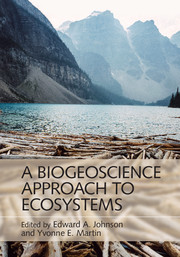Book contents
- Frontmatter
- Contents
- List of contributors
- Preface
- Miscellaneous Frontmatter
- 1 Introduction
- Part I Connecting Ecosystem and Geoscience Processes
- Part II Transport Processes and Conservation Budgets in Biogeoscience
- 3 Heat Balances in Ecological Contexts
- 4 Water Budgets in Ecosystems
- Part III Coupling Hillslope Geomorphology, Soils, Hydrology, and Ecosystems
- Part IV Coupling Fluvial and Aeolian Geomorphology, Hydrology/Hydraulics, and Ecosystems
- Index
- References
4 - Water Budgets in Ecosystems
from Part II - Transport Processes and Conservation Budgets in Biogeoscience
Published online by Cambridge University Press: 27 October 2016
- Frontmatter
- Contents
- List of contributors
- Preface
- Miscellaneous Frontmatter
- 1 Introduction
- Part I Connecting Ecosystem and Geoscience Processes
- Part II Transport Processes and Conservation Budgets in Biogeoscience
- 3 Heat Balances in Ecological Contexts
- 4 Water Budgets in Ecosystems
- Part III Coupling Hillslope Geomorphology, Soils, Hydrology, and Ecosystems
- Part IV Coupling Fluvial and Aeolian Geomorphology, Hydrology/Hydraulics, and Ecosystems
- Index
- References
Summary
Introduction
Water is the foundation of all ecosystems, whether terrestrial or aquatic. In terrestrial ecosystems freshwater not only provides critical water supply for transpiration during plant photosynthesis and drinking water for animals, but also transports, redistributes and stores energy, nutrients and contaminants. In aquatic and snow ecosystems, water is the medium in which the ecosystem functions and so its state mediates all transactions in these systems. Ecosystems are not passive responders to water but through their structure and function can manage water and associated microclimate – forests, grasslands, organic terrain wetlands, and beaver ponds being just a few examples.
This chapter will examine the surface water budget in terms of the water continuity equation as a manifestation of the hydrological cycle. To solve the continuity equation for water, the chapter will review hydrological processes and how they interact with vegetation, animals, soils, geomorphology and climate in the context of the catchment. The coupling of the mass and energy continuity equations in controlling hydrological processes will be discussed. How hydrological processes and their ecosystem interactions are managed by humans will be introduced. Then the chapter will review calculation schemes for the surface water budget via one-dimensional land surface schemes and catchment-based hydrological models, noting the data requirements, uncertainty and limitations of these models and the balance required between model complexity and physical representation of hydrology. This will give the conceptual ideas and basic mathematics of conservation laws and transport processes that form the basis of many models in the forthcoming chapters.
Hydrological Processes as a Fundamental Component of Aquatic and Terrestrial Ecosystems
Hydrological Cycle
The hydrological cycle is the flow and storage of water, as liquid, solid or vapor, on and near the Earth's surface. This cycling is a fundamental function of the Earth system and, through its associated latent energy transformations and other influences on land surface characteristics, ensures the habitability of the planet. A representation of the global hydrological cycle is found in Figure 4.1 where it can be seen that there are substantial flows between ocean and land – evaporation and river discharge from land transfer water directly to the oceans or through precipitation and ocean water is evaporated and then forms precipitation over land.
- Type
- Chapter
- Information
- A Biogeoscience Approach to Ecosystems , pp. 88 - 132Publisher: Cambridge University PressPrint publication year: 2016
References
- 3
- Cited by

